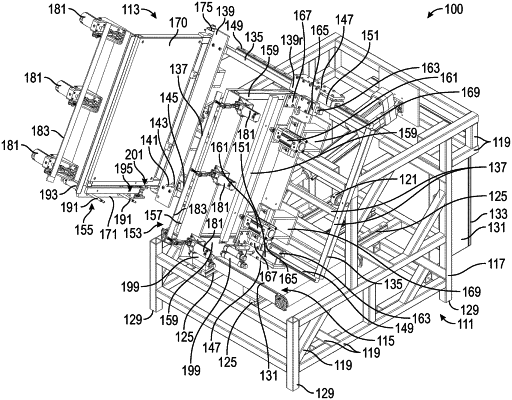| CPC B25B 11/02 (2013.01) [B25B 5/006 (2013.01); B27M 3/18 (2013.01); B27M 3/34 (2013.01)] | 14 Claims |

|
8. A jig for assembling a furniture unit, the jig comprising:
a base, wherein one or more portions of said base is configured to rest atop a surface, said one or more portions defining a plane;
a clamp assembly comprising:
a frame;
at least one front support plate connected to said frame, said at least one front support plate configured to provide a support surface for a first portion of said furniture unit during assembly;
a first jaw comprising a first side support plate configured to provide a support surface for a second portion of said furniture unit during assembly;
a second jaw comprising a second side support plate configured to provide a support surface for a third portion of said furniture unit during assembly; and
one or more actuators connected to said base and said clamp assembly, said one or more actuators configured to cause the clamp assembly to move relative to the base about a joint;
a conveyer system movably mounted relative to said base, said conveyor system configured to be moved from a retracted position to an extended position;
said jig configured to be transitioned from a first configuration to a second configuration and further configured to be transitioned from said second configuration to a third configuration, wherein:
when said jig is in said first configuration, said at least one front support plate of said clamp assembly is oriented at a first angle relative to said plane and said conveyer system is in said retracted position;
when said jig is in said second configuration, said at least one front support plate of said clamp assembly is oriented at a second angle relative to said plane and said conveyer system is in said retracted position;
when said jig is in said third configuration, said at least one front support plate of said clamp assembly is oriented at a third angle relative to said plane and said conveyer system is in said extended position; and
said first, second, and third angles are different from one another;
wherein the at least one front support plate and the first and second side support plates of the clamp assembly move about a joint axis extending through said joint when said jig is transitioned to the second and third configurations.
|